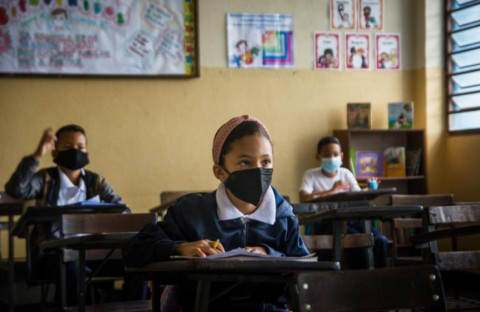
GCED Basic Search Form
Quick Search
أنت هنا
الأخبار

NEW YORK/PARIS/WASHINGTON D.C., 30 March 2022 – “More than two years into the COVID-19 pandemic, we are witnessing a colossal loss to children’s learning. Less than half of countries are implementing learning recovery strategies at scale to help children catch up. Unless all countries implement and expand programs in the coming months, they risk losing a generation.
“With a combined 2 trillion hours of in-person school lost due to school closures since March 2020, students in more than 4 in 5 countries have fallen behind in their learning. Less well-off children have seen their learning falling back. In particular, the most marginalised – those living in poverty and rural areas, children with disabilities, and the youngest students – have fallen the furthest behind.
“Basic, foundational skills upon which every aspect of education is built have been erased in many countries. Children have forgotten how to read and write; some are unable to recognise letters. Children who were poised to start school for the first time never got the chance to learn these skills in the first place, as early childhood education disappeared in most countries. Without urgent remedial action, this could carry serious lifelong consequences in terms of health and well-being, future learning and employment.
“And yet, our March 2022 data show that less than half of countries featured in a new analysis published today are implementing learning recovery strategies at scale to help children catch up on what they’ve missed. Only half of low-income countries have a plan in place to assess where those who have returned are at in their learning.
“While we have seen pockets of data that point to a staggering number of children not returning to school once their classrooms reopened, some countries are not collecting or not able to collect information on how many children have or have not returned to school, so we are flying blind. A quarter of low-income countries – already with high out-of-school populations – do not have the data to show how many students have returned to school.
“The alarm was sounded many times. Six months into the pandemic, with a lack of access to remote learning, we already knew that at least a third of schoolchildren globally were completely cut off from their education. We knew that some 24 million children and youth were at risk of dropping out altogether. We knew child labour and child marriage would rise. And yet, not enough is being done to help children recover what they’ve lost.
“At a time when it’s needed the most, education funding has and continues to fall desperately short. Countries allocated on average 3 per cent of their COVID-19 stimulus packages to education. In low- and lower-middle-income countries, the allocation was less than 1 per cent.
“While countries scramble to recover, they are overlooking the single, most-effective long-term recovery and sustainability tool – education.
“Governments must double down efforts get every child into school. Education is a fundamental human right. The multiple and intersecting barriers – including poverty, cultural norms, and poor quality teaching – preventing children from accessing their education must be broken down. Every child needs to be assessed on their learning and based on the results, they must have access to quality, tailored, catch-up classes to recover what they’ve lost and beyond. Teaching should be adjusted to the level they currently are at in their learning. Teachers must be given the training, support and resources they need. And finally, schools must go beyond places of learning and support children’s well-being and safety.
“This is a now-or-never moment to act and transform education in order to save this generation.”
###
Notes to Editors
A joint report issued today by UNESCO, UNICEF and the World Bank highlights staggering levels of learning loss globally and takes stock of the measures being taken by countries to mitigate learning losses as schools reopen. The Where are we on education recovery? report is based on a survey of 122 UNICEF country and fundraising offices administered in early March 2022. The data presented in this statement is noted in the new report which presents the importance of and progress made in five key actions for education recovery:
- Reach every child and retain them in school;
- Assess learning levels;
- Prioritize teaching the fundamentals;
- Increase catch-up learning and progress beyond what was lost; and
- Develop psychosocial health and well-being so every child is ready to learn.
